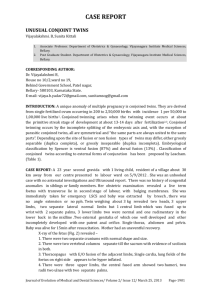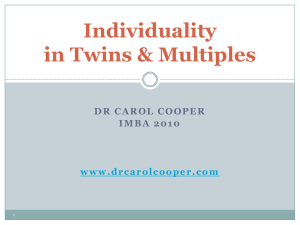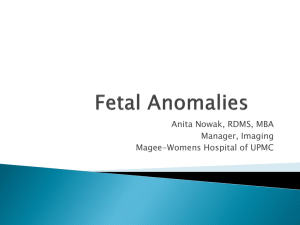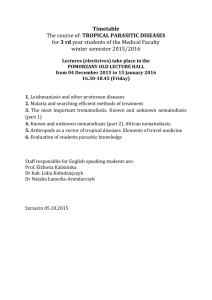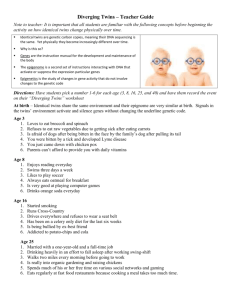Prenatal Diagnosis of Pygopagus Tetrapus Parasitic Twin: Case
advertisement
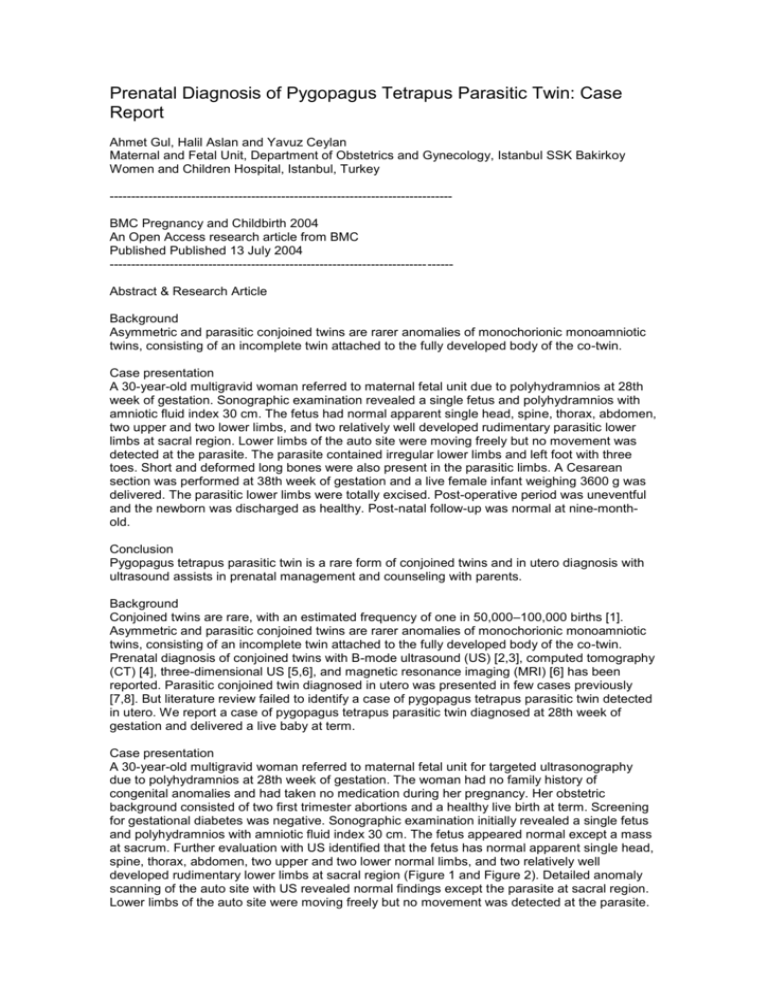
Prenatal Diagnosis of Pygopagus Tetrapus Parasitic Twin: Case Report Ahmet Gul, Halil Aslan and Yavuz Ceylan Maternal and Fetal Unit, Department of Obstetrics and Gynecology, Istanbul SSK Bakirkoy Women and Children Hospital, Istanbul, Turkey -------------------------------------------------------------------------------BMC Pregnancy and Childbirth 2004 An Open Access research article from BMC Published Published 13 July 2004 -------------------------------------------------------------------------------Abstract & Research Article Background Asymmetric and parasitic conjoined twins are rarer anomalies of monochorionic monoamniotic twins, consisting of an incomplete twin attached to the fully developed body of the co-twin. Case presentation A 30-year-old multigravid woman referred to maternal fetal unit due to polyhydramnios at 28th week of gestation. Sonographic examination revealed a single fetus and polyhydramnios with amniotic fluid index 30 cm. The fetus had normal apparent single head, spine, thorax, abdomen, two upper and two lower limbs, and two relatively well developed rudimentary parasitic lower limbs at sacral region. Lower limbs of the auto site were moving freely but no movement was detected at the parasite. The parasite contained irregular lower limbs and left foot with three toes. Short and deformed long bones were also present in the parasitic limbs. A Cesarean section was performed at 38th week of gestation and a live female infant weighing 3600 g was delivered. The parasitic lower limbs were totally excised. Post-operative period was uneventful and the newborn was discharged as healthy. Post-natal follow-up was normal at nine-monthold. Conclusion Pygopagus tetrapus parasitic twin is a rare form of conjoined twins and in utero diagnosis with ultrasound assists in prenatal management and counseling with parents. Background Conjoined twins are rare, with an estimated frequency of one in 50,000–100,000 births [1]. Asymmetric and parasitic conjoined twins are rarer anomalies of monochorionic monoamniotic twins, consisting of an incomplete twin attached to the fully developed body of the co-twin. Prenatal diagnosis of conjoined twins with B-mode ultrasound (US) [2,3], computed tomography (CT) [4], three-dimensional US [5,6], and magnetic resonance imaging (MRI) [6] has been reported. Parasitic conjoined twin diagnosed in utero was presented in few cases previously [7,8]. But literature review failed to identify a case of pygopagus tetrapus parasitic twin detected in utero. We report a case of pygopagus tetrapus parasitic twin diagnosed at 28th week of gestation and delivered a live baby at term. Case presentation A 30-year-old multigravid woman referred to maternal fetal unit for targeted ultrasonography due to polyhydramnios at 28th week of gestation. The woman had no family history of congenital anomalies and had taken no medication during her pregnancy. Her obstetric background consisted of two first trimester abortions and a healthy live birth at term. Screening for gestational diabetes was negative. Sonographic examination initially revealed a single fetus and polyhydramnios with amniotic fluid index 30 cm. The fetus appeared normal except a mass at sacrum. Further evaluation with US identified that the fetus has normal apparent single head, spine, thorax, abdomen, two upper and two lower normal limbs, and two relatively well developed rudimentary lower limbs at sacral region (Figure 1 and Figure 2). Detailed anomaly scanning of the auto site with US revealed normal findings except the parasite at sacral region. Lower limbs of the auto site were moving freely but no movement was detected at the parasite. The parasite contained irregular lower limbs and left foot with three toes. Short and deformed long bones were also present in the parasitic limbs. The parents were counseled and were informed by a multidisciplinary team of the perinataologists, the neonatologists and the pediatric surgeons. Figure 1 - Transverse section through fetal sacral region shows parasitic left lower limb at 28th week of gestation Figure 2 - Sagittal section through fetal lumbar and sacral vertebra demonstrates parasitic left lower limb at 28th week of gestation A Cesarean section was performed at 38th week of gestation and a live female infant weighing 3600 g was delivered. The placenta was single and normal. The Apgar scores were 8 and 10 at 1 and 5 min, respectively. The infant appeared to be normal except the parasitic co-twin (Figure 3 and Figure 4). The infant was further evaluated with US and MRI that confirmed that parasitic conjoined twin had no relation with the spinal cord or related structures. One weeks after birth, the infant underwent surgery. The parasitic lower limbs were totally excised. Post-operative period was uneventful and the newborn was discharged as healthy. Post-natal follows-up were normal at nine-month-old. Pathologic examination demonstrated skin covered parasitic body. Two deformed lower limbs were attached to the sacral mass. After dissection of the mass and the parasitic limbs, long bones of bilateral lower limbs and some pelvic bone were seen. Figure 3 - The baby with parasitic left lower limb, at delivery Figure 4 - The baby, at early neonatal period, has parasitic left and right lower limbs Conclusions Conjoined twinning is a fascinating congenital abnormality with devastating consequences for the twins and the family. Conjoined twins develop from a single fertilized ovum and result from failure of the division of the embryonic disk until after day 13 from conception. Seventy percent of conjoined twins are female, and 40% are stillborn [1]. Conjoined twins are categorized based on the region of connection. In one attempt to universalize the current nomenclature of conjoint twins, Spencer [9] proposed a simple and logical new classification based on the theoretical site of union (Table 1). Parasitic twins are rare form of conjoined twins and are consisting of an incomplete twin (parasite) attached to the fully developed body of the co-twin (autosite). It is classified [10] as (1) an externally attached parasitic twin, (2) an enclosed fetus in fetu, (3) an internal teratoma, or (4) an acardiac connected via the placenta. Table 1 - Classification of conjoined twins based on the theoretical site of union [9]. Table 1 Classification of conjoined twins based on the theoretical site of union [9]. Embryonic aspect Type Incidence Extent of union Ventral (87 %) Rostral (48 %) Cephalopagus 11 % Top of head to umbilicus Thoracopagus 19 % Thorax, upper abdomen, conjoined heart Omphalopagus 18 % Thorax, upper abdomen, separate hearts Caudal (11 %) Ischiopagus 11 % Lower abdomen, genitourinary tract Lateral (28 %) Parapagus 28 % Pelvis, variable trunk Craniopagus 5% Cranial vault Pygopagus 6% Sacrum Rachipagus 2% Vertebral column (midportion) Dicephalus 2 heads Diprosopus 2 faces Dorsal (13 %) Prenatal recognition of conjoined twins and precise characterization of the malformations are required for optimal obstetric management. Currently, sonographic diagnosis of conjoined twins may be straightforward if fusion of fetal parts is obvious. In utero diagnosis of conjoined twins was reported previously [2-5]. But prenatal diagnosis of parasitic conjoined twins is relatively difficult because of changing fetal positions and the rarity of these abnormalities as with any rare medical entity. Parasitic conjoined twins identified at birth were reported [11-15], but so far two cases diagnosed in utero with US and MRI were presented in the literature [7,8]. Sonographic findings in conjoined twins include inseparable fetal bodies and skin contours, no change in the relative positions of the fetuses and shared organs. Polyhydramnios is a secondary finding that occurs in 50% of conjoined twin pregnancies [15,16]. Hence the site and extent of twin fusion are variable, a careful evaluation with US may help to identify parasitic conjoined twins in utero. Differential diagnosis includes parasitic twin, fetus in fetu (internal parasite) and teratoma. Presence of rudimentary lower limbs with foot in our case suggested the parasitic conjoined twin. The prognosis depends on the site and extent of twin fusion. In our case, during routine prenatal examination, the woman had three US scanning and had no abnormal findings noted until she was referred for polyhydramnios at 28 weeks' gestation, suggesting that prenatal diagnosis is relatively difficult. Rarity of the condition may lead to misdiagnosis or undiagnosed. Although our case was referred for detailed US due to polyhydramnios, its etiology is not clear and parasitic site might have vascular malformation that may lead to increased volume of circulation, like in the cases having teratoma and arteriovenous malformations. Hyperdynamic cardiac activity and increased cardiac output might caused polyhydramnios in our case. Even though it is rare, a parasitic conjoined twin should be considered in the differential diagnosis when polyhydramnios is present. Prenatal diagnosis in our case helped in counseling with the parents and in management of the case and delivery. In conclusion, pygopagus tetrapus parasitic twin is a rare form of conjoined twin with a favorable outcome. Obstetrician should be aware of the existence of a parasitic twin during prenatal examinations and the importance of the differential diagnosis of parasite and teratoma. Delivery at a tertiary center is highly suggested for optimal neonatal intensive care and pediatric surgical intervention. Competing interests None declared. Authors' contributions AG was consulting perinatologist associated with the case and drafted the manuscript. HA was consulting perinatologist and participated in the design of the study. YC was chief director of maternal and fetal unit, and participated in its design and coordination. All authors read and approved the final manuscript. Acknowledgements "Written consent was obtained from the patient for publication of study" References 1. Edmonds LD, Layde PM: Conjoined twins in the United States. Teratology 1982, 25:301-8. 2. Daskalakis G, Pilalis A, Tourikis I, Moulopoulos G, Karamoutzos I, Antsaklis A: First trimester diagnosis of dicephalus conjoined twins. Eur J Obstet Gynecol Reprod Biol 2004, 112:110-3. 3. Sen C, Celik E, Vural A, Kepkep K: Antenatal diagnosis and prognosis of conjoined twins: a case report. J Perinat Med 2003, 31:427-30. 4. Abrams SL, Callen PW, Anderson RL, Stephens JD: Anencephaly with encephalocele in craniopagus twins:prenatal diagnosis by ultrasonography and computed tomography. J Ultrasound Med 1985, 4:485-8. 5. Sepulveda W, Munoz H, Alcalde JL: Conjoined twins in a triplet pregnancy: early prenatal diagnosis with three-dimensional ultrasound and review of the literature. Ultrasound Obstet Gynecol 2003, 22:199-204. 6. Chen CP, Shih JC, Shih SL, Huang JK, Huang JP, Lin YH, Wang W: Prenatal diagnosis of cephalothoracopagus janiceps disymmetros using three-dimensional power Doppler ultrasound and magnetic resonance imaging. Ultrasound Obstet Gynecol 2003, 22:299-304 7. Esenkaya S, Gurbuz B, Yalti S: Asymmetric parasitic dicephalus conjoined twins. J Clin Ultrasound 2004, 32:102-5. 8. Tan A, Lee SL: Prenatal diagnosis of parasitic twins using three-dimensional ultrasound: a case report. Ultrasound Obstet Gynecol 2002, 20:192-3. 9. Spencer R: Anatomic description of conjoined twins: a plea for standardized terminology. J Pediatr Surg 1996, 31:941-4. 10. Spencer R: Parasitic conjoined twins: external, internal (fetuses in fetu and teratomas), and detached (acardiacs). Clin Anat 2001, 14:428-44. 11. Gilbert-Barness E, Opitz JM, Debich-Spicer D, Mueller T, Arnold S, Quintero R: Fetus-infetu form of monozygotic twinningn with retroperitoneal teratoma. Am J Med Genet 2003, 120:406-12. 12. Kakkar N, Vasishta RK, Panwar M, Narang A, Gupta I, Banerjee AK: Chorangiopagus parasiticus twins. Pediatr Pathol Mol Med 2002, 21:551-5. 13. Szu-Yuan Chou, So-Jung Liang, Chih-Fen Wu, Chun-Sen Hsu: Sacral Parasite Conjoined Twin. Obstet Gynecol 2001, 98:938-40. 14. Kapur Vk, Kulkarni MS, Shenoy MU: Asymmetric conjoined twins. Pediatr Surg Int 1997, 12:308-9. 15. Strauss S, Tamarkin M, Engelberg S, Ben Ami T, Goddman RM: Prenatal sonographic appearance of diprosopus. J Ultrasound Med 1987, 6:93-5. 16. Barth RA, Filly RA, Goldberg JD, Moore P, Silverman NH: Conjoined Twins: Prenatal Diagnosis and Assessment of Associate Malformations. Radiology 1990, 177:201-7. The electronic version of this article is the complete one and can be found online at: http://www.biomedcentral.com/1471-2393/4/13
